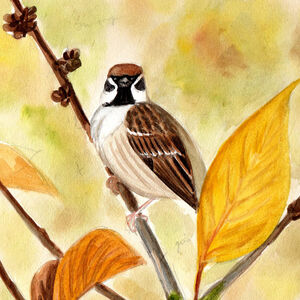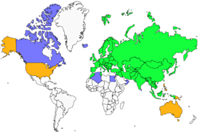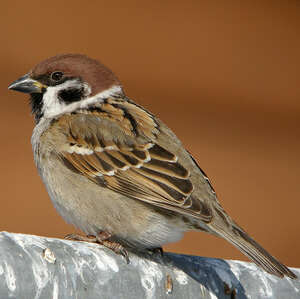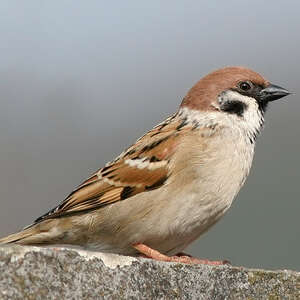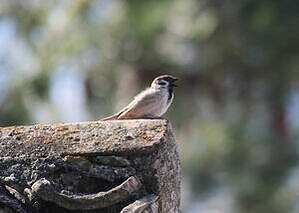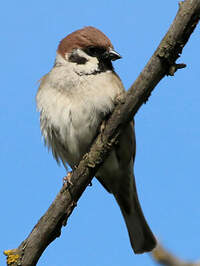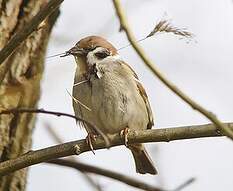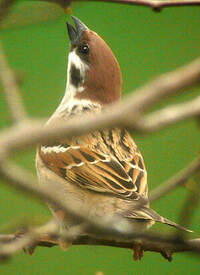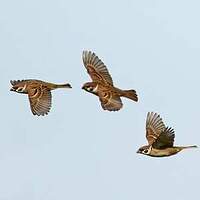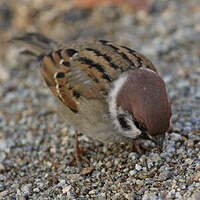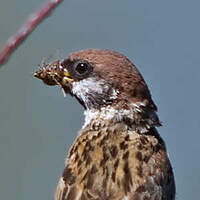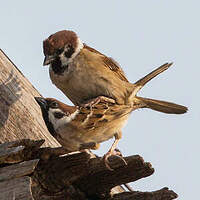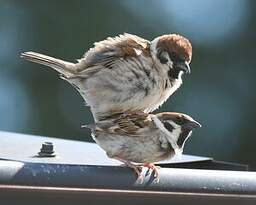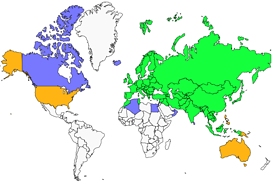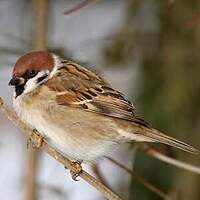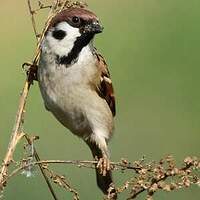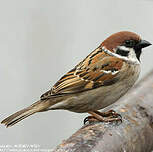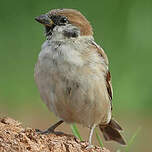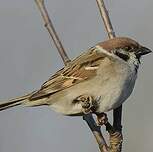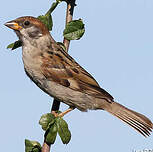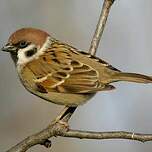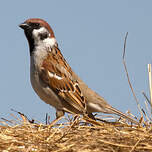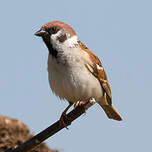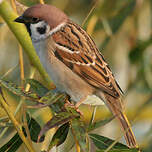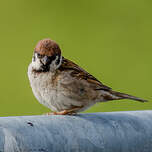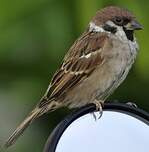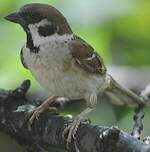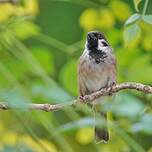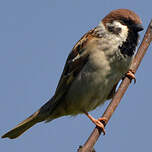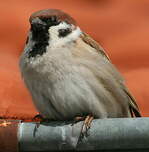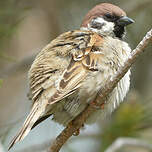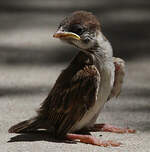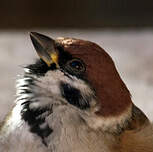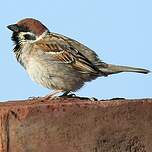Eurasian Tree Sparrow
Passer montanus - Moineau friquet
Identification
At barely smaller than its cousin, the House Sparrow, the Eurasian Tree Sparrow stands out mainly because of two features. Firstly, the species does not show sexual dimorphism. The male simply has slightly brighter hues than its counterpart. Secondly, its head is quite different. It is a brown-maroon to brick shade on its crown and nape to the parotids. The cheek is white with a clearly visible black patch underneath the eye. The brown-iris eye is hardly visible, surrounded by a black area including lores. The beak and a thin gular bib are also black. The upperparts are quite similar to the House Sparrow's, just as brightly coloured. The major differences consist of three features. Firstly, a thin whitish collar is placed between the nape and mantle. Secondly, a second whitish alar bar, narrower, is visible at the tip of the greater coverts. Finally, the sandy rump does not stand out from the rest of the topside. This last feature is visible in flight and sets the bird apart from the male House Sparrow. The underparts are a dirty white with nuances of chamois on the chest sides and flanks. The juvenile has the adult's features, but toned down and with less bright colours.
Subspecific information 9 subspecies
- Passer montanus montanus (Europe through n and c Asia to ne Siberia and ne Mongolia)
- Passer montanus dybowskii (se Siberia, ne China and n Korea)
- Passer montanus transcaucasicus (e Turkey, the Caucasus to Armenia and Iran)
- Passer montanus kansuensis (nc China)
- Passer montanus dilutus (s Kazakhstan and e Iran to nw China and s Mongolia)
- Passer montanus tibetanus (Tibet to c China)
- Passer montanus saturatus (Sakhalin and Kuril Is. and Japan though e China to Taiwan and the n Philippines)
- Passer montanus hepaticus (ne India. ne Arunachal Pradeshl. , se Tibet and nw Myanmar)
- Passer montanus malaccensis (w Nepal to Bhutan and ne India. Assam. , s China, Southeast Asia, Sumatra, Java and s Philippines)
Foreign names
- Moineau friquet,
- Gorrión molinero,
- pardal-montês,
- Feldsperling,
- mezei veréb,
- Ringmus,
- Passera mattugia,
- pilfink,
- Pilfink,
- vrabec poľný,
- vrabec polní,
- Skovspurv,
- pikkuvarpunen,
- pardal xarrec,
- Trjáspör,
- mazurek,
- lauku zvirbulis,
- poljski vrabec,
- Полевой воробей,
- Burung-gereja erasia,
- スズメ,
- 麻雀,
- นกกระจอกบ้าน,
- 麻雀〔樹麻雀〕,
Voice song and cries
The usual call is a tchip similar to that of the House Sparrow but at a higher pitch. This is a contact call between individuals in this sociable species. The breeding male uses it and its variants - tchirp, chup tchirip... - in the spring to defend the territory near the nest by delivering long monotonous sequences. The alarm call is a quickly uttered succession of dry notes, tedededede, reminiscent of the call of the Eurasian Tree Sparrow, emitted in similar circumstances.
Habitat
While its relative the House Sparrow is the bird of the city, the Eurasian Tree Sparrow is the bird of the country, at least in Europe because its distribution area is vast.
Behaviour character trait
The Eurasian Tree Sparrow shares many similarities with its cousin, the House Sparrow. Like it, the Tree Sparrow is gregarious in all seasons, colonially or semi-colonially reproducting during the breeding season, and mostly sedentary in low latitudes.
Since it is less attracted to humans, the general public has fewer opportunities to see it, especially since it is active and relatively shy. Out of the breeding season, one could see it in mixed groups with the House Sparrow, although it stands out less than the latter. Nevertheless, it is quite talkative, with cries similar to the House Sparrows. These gatherings can be quite spectacular when all the birds in the group rush to the nearest clumps of bushes when alerted. In winter, they are often seen at artificial feeding stations in the company of titmice and other passerines. Not all Tree Sparrows are sedentary; tracking post-nuptial migration suggests that the northernmost populations must leave their breeding grounds to winter further down south.Flight
The flight is typical of a sparrow, similar to that of the House Sparrow. It is also energetic, perhaps even faster in proportion to its size, and punctuated by typical calls.
Dietfeeding habits
The diet of the Eurasian Tree Sparrow is similar to that of the House Sparrow, with a predominance of herbaceous seeds, including cereals, in all seasons and a small portion of animal prey, insects and arachnids, particularly for the feeding of chicks.
It feeds on the ground or in low vegetation, in pairs or small groups during the breeding period, in larger and mixed groups in the off-season. It is then that it can be found in the harvested fields in the company of finches and buntings for example.Reproduction nesting
The species is a hole-nesting bird, primarily nesting in cavities in old trees, old fruit-bearing trees in orchards for example, or old willows or poplars in damp areas.
It also occupies cavities in rocky environments, in cliffs or in old walls, or else rodent and bird burrows such as those of the Sand Martin on the steep banks of rivers or in gravel quarries, etc. It readily takes advantage of nest boxes for hole-nesting birds. Hollow metal structures like those found on electricity pylons are also occupied. Finally, its nesting in the large nests of the White Stork or of large raptors is well-known and documented. The rarity of nesting sites may be the cause of a decline, as has been seen in many places due to the disappearance of old orchards. The nest is made like the domesticated one, of vegetal elements (linear stems and leaves, rootlets) lined with feathers and animal fur. Towards the end of April, the female lays 2 to 7 white eggs, on average 5 or 6, which will be incubated for 11 to 14 days. The stay in the nest is 15 to 20 days. A second laying is likely usual.Geographic range
The Eurasian Tree Sparrow is a species found throughout the Eurasian continent, from the Atlantic to the Pacific. In the north, it reaches subarctic zones in Siberia, while in the south, it only lightly brushes the African continent by spilling over into Morocco in winter and breeding in the extreme northeast of Tunisia. However, in the eastern part of its range, its distribution is larger and includes most of Russia, all of China, Southeast Asia and Indonesia, but neither Australia nor New Guinea. In this vast area, nine subspecies are recognized, with the type subspecies occupying the west and the north. As with the domesticated variety, introductions were attempted in the 19th century, which were successful in the United States (Missouri and Illinois) and in southeastern Australia.
Threats - protection
IUCN conservation status
concern
in the Wild
threatened
evaluated
The Eurasian Tree Sparrow is not threatened on a large scale as its range is very large. There has been an expansion in its range to the north, such as in Scandinavia, likely linked with climate change, and to the south as in Southeast Asia. Nevertheless, as is the case in France, there has been a decline in this species since the second half of the 20th century in highly developed countries, likely due to habitat loss. At the same time, the species was considered a pest in agriculture in China and systematically eliminated, as well as other seed eaters, through targeted campaigns. The abandonment of those destructions at the end of the century due to their ineffectiveness brought the species to a positive demographic.
Sources of information
- IOC World Bird List (v14.1), Gill, F and D Donsker (Eds). 2024-04-18.
- Les passereaux d'Europe, tome 2, P. Géroudet, M. Cuisin
- Avibase, Lepage Denis
- HBW Alive,
- xeno-canto, Sharing bird sounds from around the world,
Other sources of interest
 Specification sheet created on
17/07/2023 by Jean François
Specification sheet created on
17/07/2023 by Jean FrançoisTranslation by AI Oiseaux.net
published: 12-12-2017 - Updated: 07-02-2018
© 1996-2024 Oiseaux.net
- Accipitriformes
- Aegotheliformes
- Anseriformes
- Apodiformes
- Apterygiformes
- Bucerotiformes
- Caprimulgiformes
- Cariamiformes
- Casuariiformes
- Charadriiformes
- Ciconiiformes
- Coliiformes
- Columbiformes
- Coraciiformes
- Cuculiformes
- Eurypygiformes
- Falconiformes
- Galliformes
- Gaviiformes
- Gruiformes
- Leptosomiformes
- Mesitornithiformes
- Musophagiformes
- Nyctibiiformes
- Opisthocomiformes
- Otidiformes
- Passeriformes
- Pelecaniformes
- Phaethontiformes
- Phoenicopteriformes
- Piciformes
- Podargiformes
- Podicipediformes
- Procellariiformes
- Psittaciformes
- Pterocliformes
- Rheiformes
- Sphenisciformes
- Steatornithiformes
- Strigiformes
- Struthioniformes
- Suliformes
- Tinamiformes
- Trogoniformes

